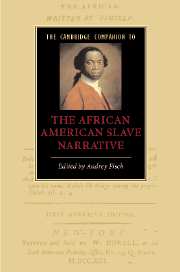Book contents
- Frontmatter
- Introduction
- Part I: The Slave Narrative and Transnational Abolitionism
- 1 The rise, development, and circulation of the slave narrative
- 2 Politics and political philosophy in the slave narrative
- 3 Olaudah Equiano: African British abolitionist and founder of the African American slave narrative
- 4 The slave narrative and the literature of abolition
- Part II: The Slave Narrative and Anglo-American Literary Traditions
- Part III: The Slave Narrative and the African American Literary Tradition
- Part IV: The Slave Narrative and the Politics of Knowledge
- Further Reading
- Index
2 - Politics and political philosophy in the slave narrative
from Part I: - The Slave Narrative and Transnational Abolitionism
Published online by Cambridge University Press: 28 July 2007
- Frontmatter
- Introduction
- Part I: The Slave Narrative and Transnational Abolitionism
- 1 The rise, development, and circulation of the slave narrative
- 2 Politics and political philosophy in the slave narrative
- 3 Olaudah Equiano: African British abolitionist and founder of the African American slave narrative
- 4 The slave narrative and the literature of abolition
- Part II: The Slave Narrative and Anglo-American Literary Traditions
- Part III: The Slave Narrative and the African American Literary Tradition
- Part IV: The Slave Narrative and the Politics of Knowledge
- Further Reading
- Index
Summary
The slave narratives were intensely political documents. Although one may find many motivations behind their writing, all were published to play a role in the fight against slavery. Encouraged by the rise of the abolitionist movement in the 1830s, the narratives quickly became that movement's most essential texts, providing eyewitness accounts of slavery's brutal reality. Most of the authors were themselves active abolitionists who had told their stories on the platform prior to setting them down in print. Both they and their colleagues believed the narratives could strike a telling blow against slavery.
The narratives' political purposes also contributed to their shape and content. Written to serve the abolitionist cause, the narratives quickly developed a set of rhetorically effective conventions with great political resonance in antebellum America, based on significant, systematic political ideas.
The political character of abolitionism was itself a complex matter. The movement's roots, and those of the slave narrative, lay in efforts to oppose slavery that had appeared both in Britain and its American colonies by the 1680s. During the eighteenth century, and into the era of the American Revolution, such former slaves as Ayuba Suleiman Diallo (Job ben Solomon) and Olaudah Equiano, their works well known on both sides of the Atlantic, recounted their experiences in order to further that opposition. Still, both in Britain and the United States, the development of the slave narrative as a form was closely connected to the rise of American abolitionism as an organized force, formally marked, beginning in 1833, by the formation of the American Anti-Slavery Society (AASS), led by William Lloyd Garrison, Robert Purvis, and others.
- Type
- Chapter
- Information
- Publisher: Cambridge University PressPrint publication year: 2007
- 8
- Cited by



